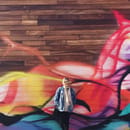In the years following the enactment of the Slavery Abolition Act in 1834, Thomas D. Rice, known for his stage name “Daddy Rice”, made a name for himself as an American performer and playwright who gave birth to a trend in popular theatre that fascinated white audiences around the world—blackface.
Photo of Al Jonson character as Sambo, 1925 (source: History.com)
Drawing from aspects of African American Culture, Rice would entertain audiences by painting his face black as a means of caricaturing the appearance of African Americans and the “Jim Crow” persona, gaverise to a violent chain of widespread racist stereotypes that fueled the dehumanization of “the other” and continued to honor a tradition of white supremacy.
I bring your attention to Rice in order to highlight the innate performance aspect of blackface, as it was in the past—an opportunity to caricature anti-Black sentiment for sheer entertainment. I must note that understanding the past tense nature of blackface is crucial.
The vilifying trope of deficient and mystifying “black character” is acted upon by intentionally caking one’s face in black makeup and dressing up in a costume to make a mockery of an imagined and alienated character based off of the African American identity. The caricature of the backwards, angry, and unwanted black character pushes the narrative of exclusion of those with darker skin from the “white man’s world”, a mindset that was highly saturated by the social context of segregation and violent social alienation targeting African Americans during the Jim Crow era in the 1800s. Needless to say, making a mockery of the foolish black character considered to be “the other,” placed African Americans on display only to be ridiculed, disrespected and made to feel like outsiders locked in the bordered walls of a toxic white supremacist tradition. By highlighting histories of violent racism and anti-Black motivations that gave rise to blackface’s emergence, we can understand the crucial significance of its disgraceful and condemned nature in the 21st century.
Moving forward, simply stating that the “past is the past” does not erase the history of violence, abuse, and racial hatred and segregation faced by people of color. While the horrors of racism remain as a dark part of history, underlying themes of covert racism remain very much alive in the present day.
Fast forward to the 21st century, one would think that racist attitudes and blatant mockeries of “the other” such as blackface would have died down after years of being highly condemned. Unfortunately, some learn faster than others when it comes to understanding what tolerance, diversity, and multiculturalism mean in the 21st century. These three words may stand out in particular to a reader’s eyes. Why? These are the same core values that Prime Minister Justin Trudeau of Canada has championed and continuously emphasized as the central goals fueling his position in office over the past 4 years.
Photo of Trudeau following his election in 2015. (Source: Justin Trudeau @pm.gc.ca)
In the wake of a series of disturbing photos and videos showing Trudeau dressed in blackface dating back to 2001, the values that once stood at the center of his political identity are now being thrown back in his face and being criticized for their hypocrisy.
I couldn’t help but have this thought cross my mind—If someone else in Canada were to decide to paint themselves in black makeup and a turban and play dress-up today, I’m sure that Trudeau would surely have something to say about how disgraceful, disrespectful, and unacceptable such a racist act is. To go even further, condemning acts that oppose Trudeau’s cherished values of diversity and multicultural appreciation would serve as a highly effective campaign motivator. Interesting how that turned out.
The, not one, but 2 photos and a video that sent shockwaves across the country and beyond Canada’s borders unmask what lies beneath Trudeau’s multicultural rhetoric of acceptance that has placed the nation as a pillar of strength for human diversity on a global stage. Not to mention our advertised “nicer” and “less racist” identity that supposedly makes us polar opposites of our American neighbors. Perhaps formally known for having a dreamy-eyed prime minister that spoke fondly of fostering diversity and championing multiculturalism, Trudeau’s skeletons in his closet have come out, and, reality check, they aren’t so dreamy. If racist acts such as blackface emerge where diversity is not recognized, nor cultivated or respected, why and how did it emerge at the hands of our very own Prime Minister?
Photo from West Point Grey Academy yearbook (Source: TorontoSun)
Photo of Justin Trudeau from Jean Brebeuf high school (Source: BBC)
For someone who has spent the last four years pushing for a greater move towards embracing values of tolerance, multiculturalism, and diversity, the photos dating back to only 18 years ago have left people to question who exactly Canada’s beloved Golden Boy is and when exactly he decided to suddenly shift to believing in said values.
“I should have known better. It was something that I didn’t think was racist at the time, but now I recognize it was something racist to do and I am deeply sorry,” said the Prime Minister when first confronted by reporters in the minutes after the Arabian Nights themed party photos were released to the public eye.
We teach our children from a young age the importance of inclusion and tolerance in hopes of raising strong open-minded learners. We pass on life lessons learned from the past to those that come after us, in hopes of supporting the growth of tolerant, respectful, and reflective leaders of tomorrow. Yet, as an educator of 29 years old with the very responsibility of implementing values of tolerance, Trudeau somehow missed the memo that blackface was not only no longer à la mode but a disgraceful act of blatant ignorance. The core of the issue is that painting one’s face in black or brown makeup was not acceptable when Trudeau was a child and remains inexcusable at 29 years old in 2001.
“The fact of the matter is that I’ve always—and you’ll know this—been more enthusiastic about costumes than is somehow, is sometimes appropriate,” said Trudeau
Photo of Trudeau during his visit to the holy Sikh shrine of Golden temple in Amritsar, India in 2018. (Source: Pri.org)
From being caked head to toe in dark brown makeup to wearing a turban and holding his brown painted hand across a woman’s neck, the photo is nearly impossible to un-see. As he has shared, this has not been the only instance where Trudeau thought that it was “okay” to play dress-up by painting mocking caricatures of people of colour. A baton of ignorance is waved as an evident blind eye is turned to the ways in which exotic othering perpetuates racist stereotypes, and even in 2001 which, last time I checked, was only 18 years ago. Where it may have been embarrassing and cringy to say that he is “deeply pissed off with himself” in the wake of the disgraceful scandal, responding that you “thought it was okay at the time” does not get you very far.
Is Canada’s international darling guilty of racism or political incorrectness? An expected debate that has arisen in the wake of the scandal. While Trudeau’s actions may not have been fueled by malicious or ill-will intentions, the action itself is one of sheer disrespect that does not necessarily make Trudeau a blatant racist, but an ignorant fool who was oblivious to the inexcusable nature of his actions. In other words, how much can a “youthful mistake” be excused when it took place in a time where despicable and racist actions such as blackface was still heavily condemned?
As the image stared back at my friend and me on the television, my friend’s gut reaction was to exclaim, “how could someone be so stupid?!” Unfortunately, my response at that moment was to conclude that, apparently, not everyone that is supposed to be a “grown-up” evidently “grows up”. Not even our very own Prime Minister.
How a teacher of 29 years of age at the time, and now our current Prime Minister, could have thought that such a despicable action, alluding to dark histories of racial abuse and targeted violence, could have been considered acceptable even in 2001, not only makes me question how far we really thought to have come but, more importantly, what tolerance means in the 21st century.
Twitter post by Jagmeet Singh on September 18th, 2019 (Source: Twitter)
A drama teacher painting his face in black makeup, putting on a turban, and “playing pretend” for sheer entertainment diminishes the reality of many children and adults that live “the part” every day. Treating the identity of ethnic minorities as a caricature, the images belittled people of colour by reducing their unique experience to the colour of their skin, showing a lack of empathy and respect.
From the child that was bullied and excluded for the color of their skin, to the prejudice faced by Muslim women and Sikhs who are barred from their profession due to a toxic stigma against wearing traditional markers of their religion, the constant everyday battles that one may endure for their appearance is no opportunity to play dress up. However, many of these children and grown adults live in the shadow of their “othered” identity that turns heads in the public eye and come to learn that their alienation is more immoral than natural, yet more real than imaginary.
Where a photo is worth a thousand words, these photos told a million stories. The stories of those who are targeted by racist assaults and violence in a country where Trudeau stands as a leader. The stories of the children that get harassed for the colour of their skin every day. Most importantly, it has told a revealing story that is set to stay with us for a while—the one that makes us question what our allies become when the doors are closed.
Whether it is 2019 or 2001, instead of understanding racism and ignorance for diversity as being a part of the supposed world that people of color have inherited, I challenge us to think about such ignorant thinking as existing in a world that has not yet fully moved forward. My two cents? We’ve got a long way to go.



